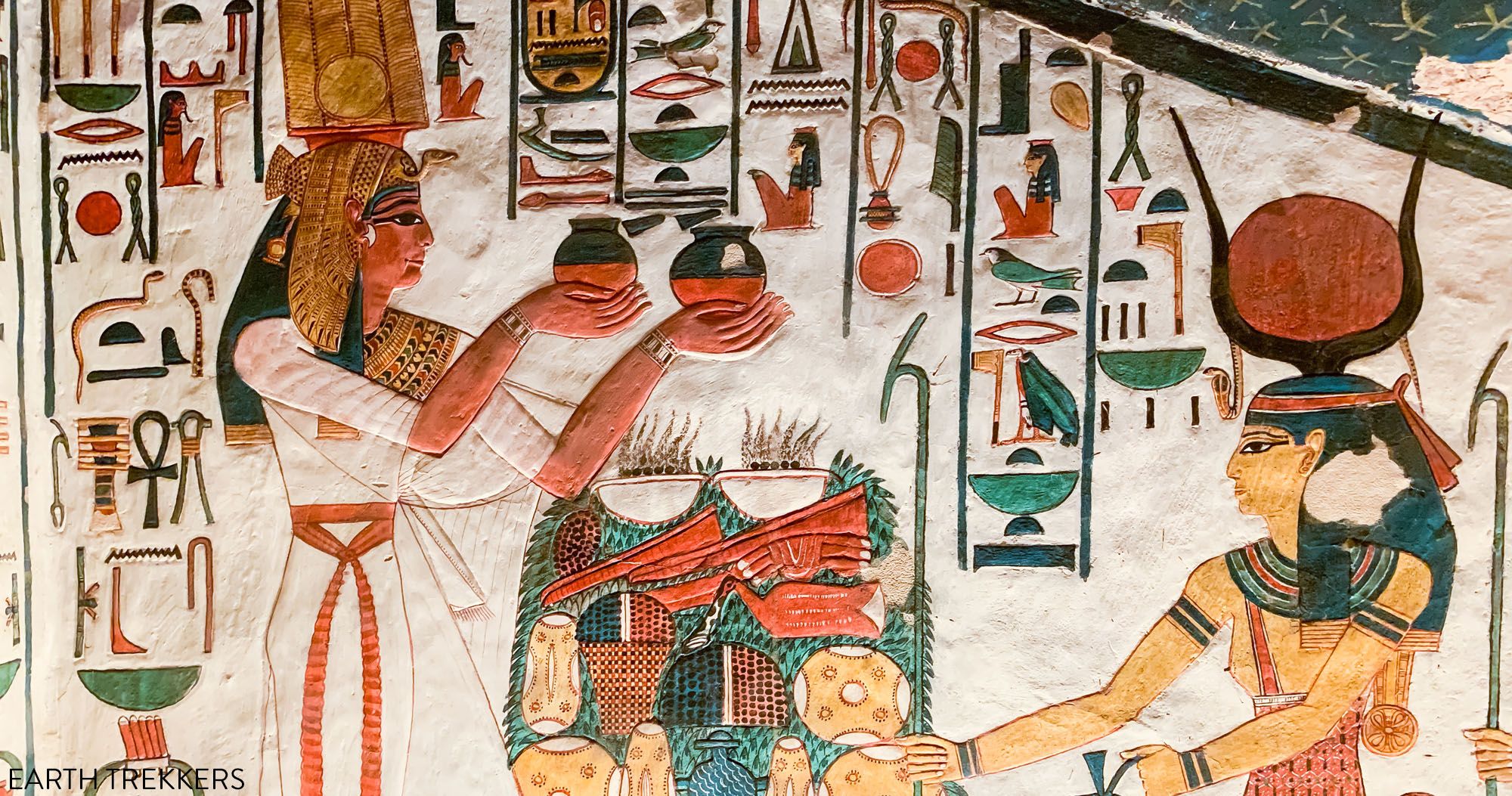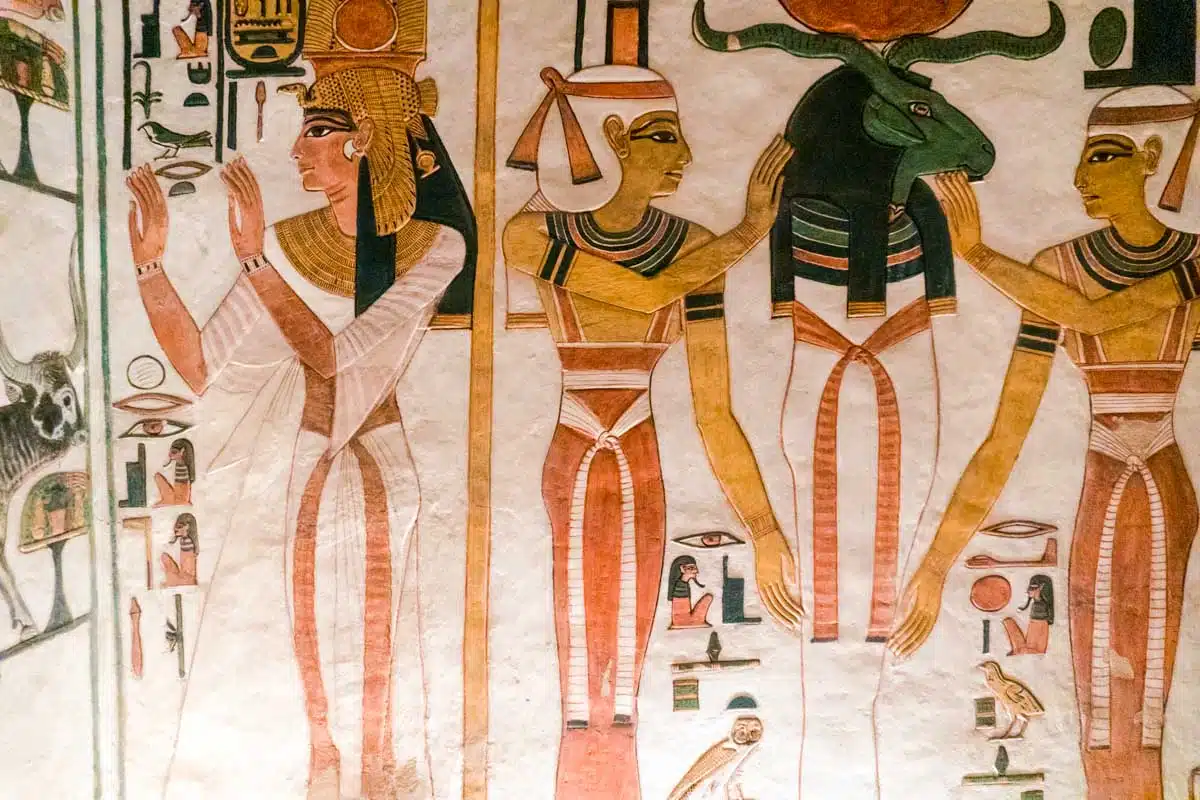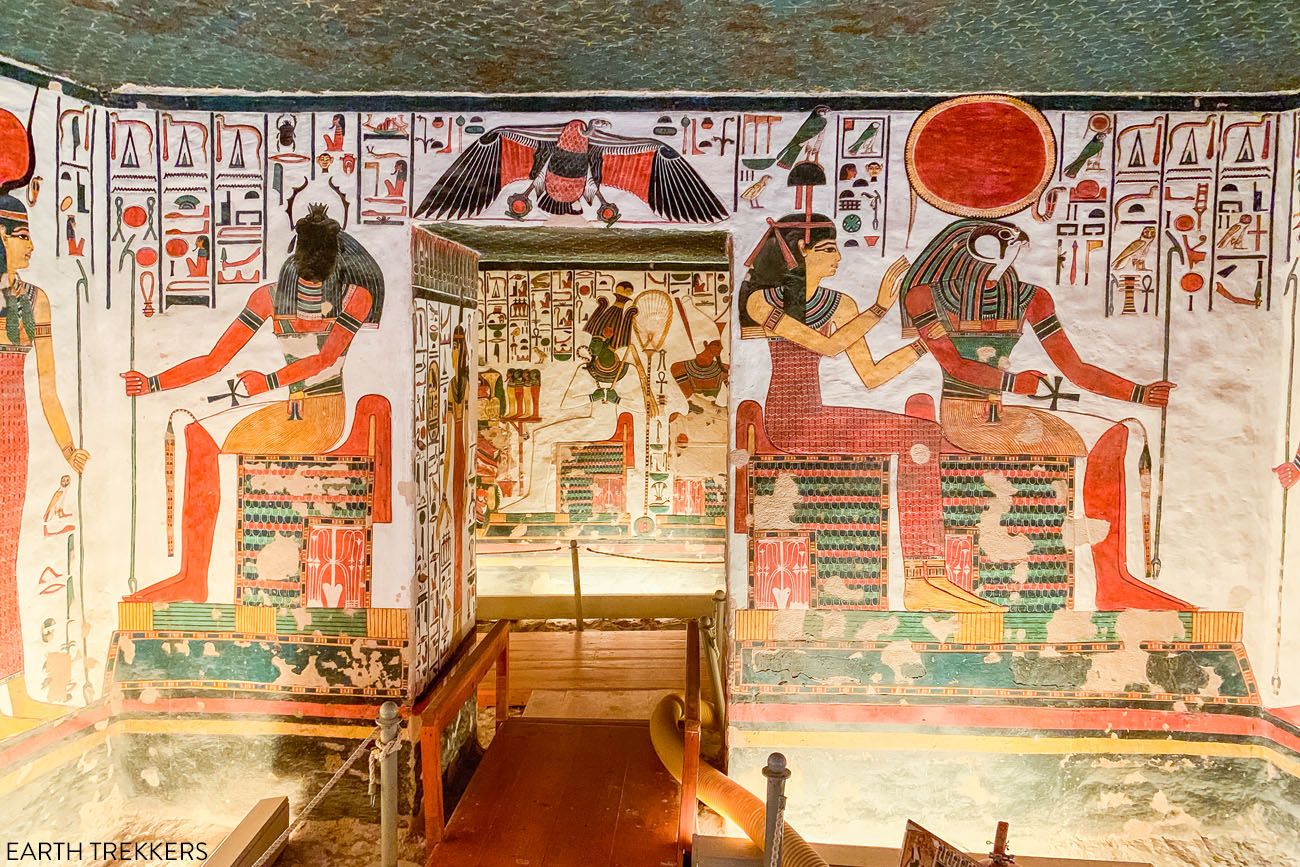Journey Through Time: Nefertari's Tomb - Luxor's Masterpiece

Hello there, welcome to our blog about the famous Queen Nefertari's Tomb. In this article, we will provide a brief overview of the tomb and its significance in the history of ancient Egypt. We will also discuss some background information about Queen Nefertari and the era in which she lived.
Overview of Nefertari's Tomb
Nefertari's Tomb is located in the Valley of the Queens in Luxor, Egypt. Ramesses II constructed it in the 13th century BC for his beloved wife, Queen Nefertari. The tomb is one of the most beautifully decorated tombs in the valley, and it is renowned for its exquisite paintings that depict scenes from daily life and various religious ceremonies.
The tomb has several chambers, including an antechamber, a burial chamber, and several smaller side chambers. The walls of these chambers are adorned with intricate paintings that have been remarkably well-preserved over the centuries. The paintings depict scenes from the Book of the Dead, a collection of spells and rituals intended to help the deceased navigate the afterlife.
Background on Queen Nefertari and the era
Queen Nefertari was one of the most influential queens of ancient Egypt. She was the Great Royal Wife of Ramesses II and played a significant role in Egyptian politics and diplomacy. Her subjects highly respected Nefertari, and she was considered a symbol of grace, wisdom, and fertility.
The era in which Nefertari lived was marked by significant cultural and artistic development. During this time, Egypt experienced a period of great prosperity and had a thriving economy. The pharaohs of this era were known for their grand temples, elaborate tombs, and grandiose building projects.
Nefertari's Tomb is a remarkable monument that provides a fascinating glimpse into the ancient world of Egypt. It is a testament to the incredible artistry and craftsmanship of the ancient Egyptians, and it stands as a reminder of the power and grandeur of ancient Egypt. Thank you for reading our blog, and we hope you found this article informative.

Discovery of the Tomb
Welcome back to our blog about Queen Nefertari's tomb. This section will focus on the tomb's discovery and its significance to the world.
History of the Discovery
The discovery of Queen Nefertari's tomb was accidental. 1904 Italian archaeologist Ernesto Schiaparelli excavated in the Valley of the Queens when some workers stumbled upon the tomb. The site was covered in debris, and stone fragments blocked the entrance. Schiaparelli and his team cleared the debris and found a simple entrance leading to the burial chamber.
Once inside, Schiaparelli discovered that the tomb had been looted in ancient times. However, many of the beautiful wall paintings were still intact. Unfortunately, the tomb was closed to the public shortly after its discovery, and it wasn't until 1995 that visitors were once again allowed to enter.
Significance of the Discovery
The discovery of Nefertari's tomb was significant for some reasons. Firstly, it gave us a glimpse into the life and culture of ancient Egypt. The paintings on the tomb walls depicted fantastic scenes of gods, goddesses, and hieroglyphics.
Secondly, the tomb is significant because of its remarkable state of preservation. The tomb's ceiling, walls, and pillars are all decorated with murals that have retained their vibrant colours even after 3,000 years.
Finally, the discovery of Nefertari's tomb is significant because it sheds light on one of the most powerful queens in ancient Egypt. The tomb was built for Nefertari, who was not only a queen but also a politician, diplomat, and patron of the arts.
The discovery of Queen Nefertari's tomb was a remarkable find that is still celebrated today. It gave us a unique opportunity to look into the past and learn more about the culture and traditions of ancient Egypt. Thanks for reading our blog, and we hope you found this section informative.

Tomb Design and Architecture
In this section, we will explore the design and architecture of the tomb, one of the most magnificent tombs of ancient Egypt.
Layout of the Tomb
Queen Nefertari's tomb is in the Valley of the Queens, next to the famous Valley of the Kings, in Luxor, Egypt. The tomb is carved into the rock, consisting of several chambers and corridors.
The first chamber, the antechamber, has four pillars decorated with reliefs showing the queen making offerings to the gods. The second chamber, the burial chamber, is the most impressive and contains a beautiful sarcophagus made of pink granite. The sarcophagus that contained the queen's mummy was missing, probably stolen in ancient times.
The third chamber, the annexe, has a smaller sarcophagus. Finally, at the end of the tomb, there is a small, unfinished chamber that might have been intended for Nefertari's ka, or life force, to reside.
Decorative Elements and Symbolism
The tomb's walls are adorned with beautiful, elaborate paintings showing Nefertari with various gods and goddesses. The colours used in the paintings are still vibrant, depicting scenes from the Book of the Dead, an ancient Egyptian funerary text.
The wall artwork also includes hieroglyphics, symbolic images, and representations of gods and goddesses such as Isis, Osiris, and Anubis. These paintings and images were created to guide Nefertari's spirit through the afterlife and ensure her safe passage to the realm of the gods.
Queen Nefertari's tomb is a magnificent work of art that showcases the skill and talent of the ancient Egyptian craftsmen. Its layout, decorative elements, and symbolism tell a fascinating story about one of the most powerful queens of ancient Egypt. Thanks for reading our article, and we hope you found it interesting!
Conservation Efforts
In this section, we'll consider conserving this magnificent tomb for future generations.
Challenges faced in preserving the tomb
Preserving such an ancient and delicate structure as Queen Nefertari's tomb is challenging. One of the main challenges is the natural deterioration of the limestone walls due to Salt weathering and moisture. Over the years, dust, moisture, and visitors have contributed to the slow deterioration of the wall paintings. The hermetic sealing of the tomb also has made ventilation an issue.
Techniques used in conservation
Several conservation techniques have been employed to preserve the tomb and its paintings. The application of nanomaterials is one of the methods used to protect fragile paintings and prevent salt weathering. Other techniques used include:
- Controlling humidity and temperature levels within the tomb
- Developing foam dolts to support the fragile ceiling
- Removing old adhesives and coatings previously applied to the murals•Resting frescoes and cleaning the accumulated salt•Using infrared thermography to detect and evaluate receptors in the frescoes.
These careful and intricate efforts have helped to conserve the tomb and ensure it remains accessible for future generations.
Preserving such an ancient structure as Queen Nefertari's tomb presents many challenges that require creative solutions, but the conservation techniques ensure that the tomb survives long into the future. The work done to preserve this magnificent tomb not only showcases the beauty of ancient art but also serves as a reminder of the importance of valuing history and culture.
Importance of Nefertari's Tomb
Nefertari's tomb is a remarkable art piece that provides a window to the past. It holds great importance in Egyptian history and provides an insight into the life, beliefs, and traditions of the ancient Egyptians. In this section, we will delve into the significance of Nefertari's tomb and its relationship to other tombs in the Valley of the Queens.
Significance of the tomb in Egyptian history
Nefertari was the first wife of Ramses II and played a significant role in the history of ancient Egypt. The tomb was built during the 19th dynasty, and its remarkable mural paintings are a testament to the royal affluence and cultural achievements of the time. The tomb is a breathtaking example of Egyptian art that uses intricate symbolism and exquisite details to depict religious scenes, hieroglyphs, and the queen's journey into the afterlife.
The tomb also holds immense significance in terms of archaeology and Egyptology. It provides an insight into the ancient Egyptians' burial rituals, methods, and beliefs, which have helped unravel mysteries about their culture and way of life.
Relationship to other tombs in the Valley of the Queens
The Valley of the Queens is home to several tombs, and Nefertari's tomb is considered the most magnificent among them. The valley was a burial ground for queens and other royal family members during the 18th and 20th dynasties.
Compared to other tombs in the valley, Nefertari's tomb stands out due to its stunning artistry and the quality of its preservation. The intricate efforts to conserve the tomb showcase the immense value of preserving ancient culture and history.
Nefertari's tomb is important in Egyptian history and is a remarkable piece of art with immense cultural significance. Its preservation showcases the importance of conserving cultural heritage for future generations to appreciate and understand.
Visitors' Experience
Accessibility and logistics of visiting the tomb
Visiting Nefertari's tomb can be an unforgettable experience for anyone interested in history and art. However, it requires prior planning and consideration to make the visit comfortable and enjoyable.
The tomb is located in the Valley of the Queens, easily accessible from Luxor by car or taxi. The site is open from 6 am to 5 pm, but it's good practice to arrive early to avoid the crowds and the heat. Visitors must purchase a separate ticket to enter the tomb; reservations are recommended in advance.
Tourists cannot bring food and drinks inside the tomb, and photography is strictly prohibited. Visitors must wear comfortable shoes and dress appropriately for the weather and culture.
Tips for making the most of the experience
To make the most of the experience, visitors should take a guide or an audio tour for a better understanding of the history and significance of the tomb. The murals and paintings are intricately detailed, so a magnifying glass can help appreciate the artistry better.
Nefertari's tomb is typically crowded and can get hot and stuffy, so taking breaks, bringing a hat or umbrella for shade, and carrying a water bottle can help keep visitors comfortable. Visitors should also plan for some extra time to walk around the rest of the tombs in the Valley of the Queens, which showcase the royalty's burial customs and architecture.
In conclusion, visiting Nefertari's tomb is an excellent way to appreciate ancient art and history. Nonetheless, visitors need to plan to make the most of the experience comfortably. The tomb's accessibility and tips provide the necessary information for a memorable visit, and the beauty of the tomb's artistry remains awe-inspiring for all visitors.
Nefertari's Legacy
Impact of Queen Nefertari on Egyptian history and culture
Queen Nefertari was one of the most prominent queens of ancient Egypt, married to Pharaoh Ramses II in the 13th century B.C. Her tomb in the Valley of the Queens is considered one of the masterpieces of ancient Egyptian art and architecture. The tomb's murals depict scenes from various religious and royal ceremonies and illustrate the queen's life, afterlife, and ascent to the heavens.
Queen Nefertari's tomb offers a unique insight into the religious beliefs and traditions of the ancient Egyptian civilization, who celebrated the cycle of life and death through elaborate burial customs. The intricate paintings and statues adorning her tomb reflect the queen's beauty, wisdom, and royal status. Nefertari's tomb also reveals women's significant role in the religious, political, and cultural development of ancient Egypt.
Legacy of the tomb's discovery
The discovery of Queen Nefertari's tomb by archaeologist Ernesto Schiaparelli in 1904 was a turning point for Egyptology and archaeology. The tomb's pristine state and exceptional artwork provided an insight into ancient Egyptian art's intricacies and innovation. The discovery also renewed interest in the Valley of the Queens and sparked extensive excavations and studies of other tombs.
Nefertari's tomb's conservation and restoration have been ongoing for decades, with many international teams collaborating with the Egyptian government to ensure that the tomb remains preserved for future generations. The legacy of Nefertari's tomb extends beyond artistic and cultural appreciation; it continues to contribute to Egypt's tourism industry, offering visitors an unforgettable glimpse into ancient life and history.
Queen Nefertari's impact on Egyptian history and culture cannot be overstated, and her tomb remains one of Egypt's most significant treasures. The legacy of the tomb's discovery and conservation has been far-reaching, contributing to our understanding of ancient Egyptian art, culture, and burial customs. The admiration and fascination with Nefertari and her legacy will last for many more centuries.
